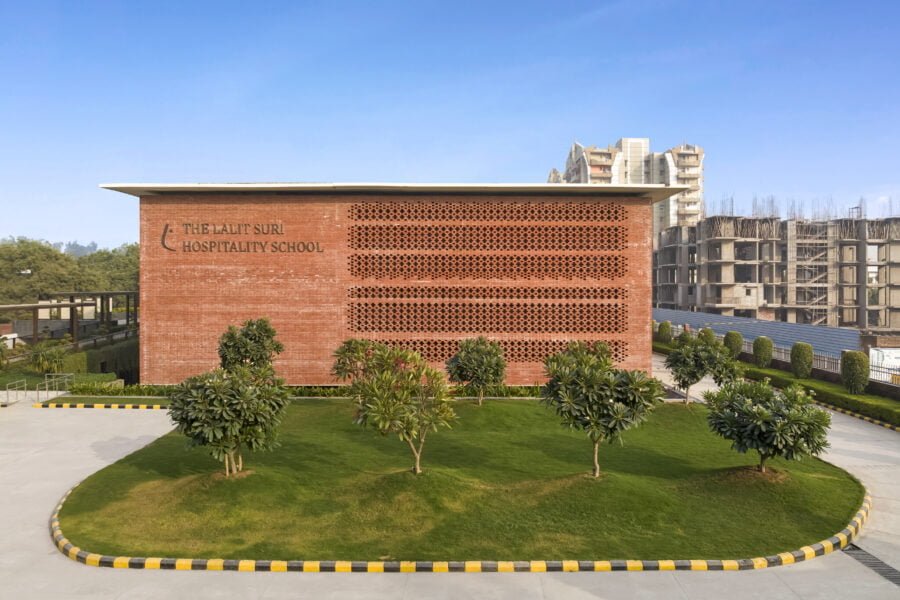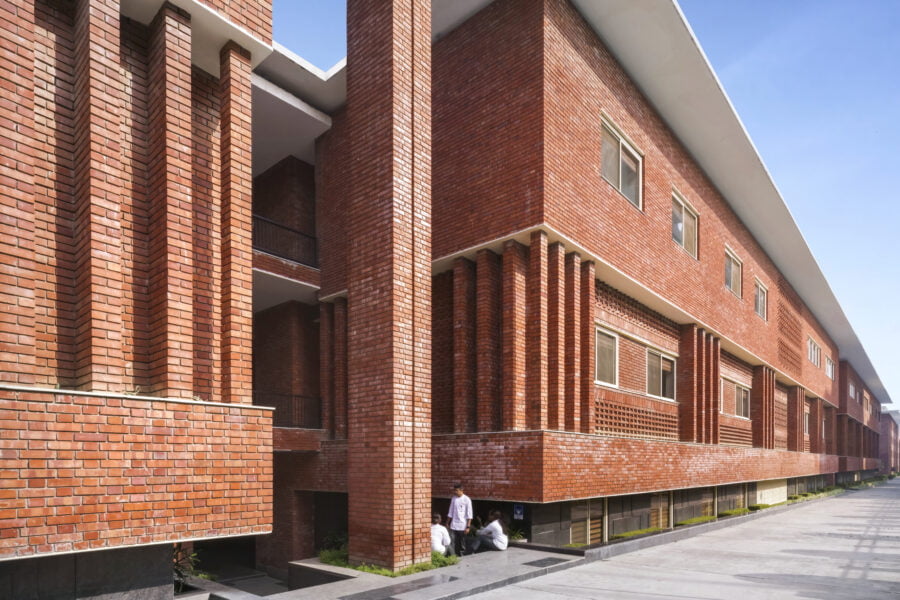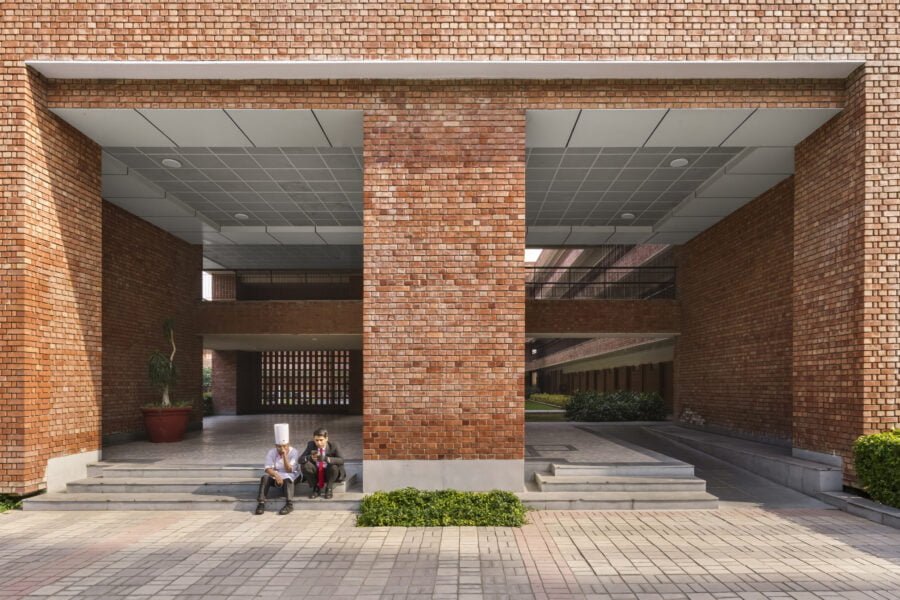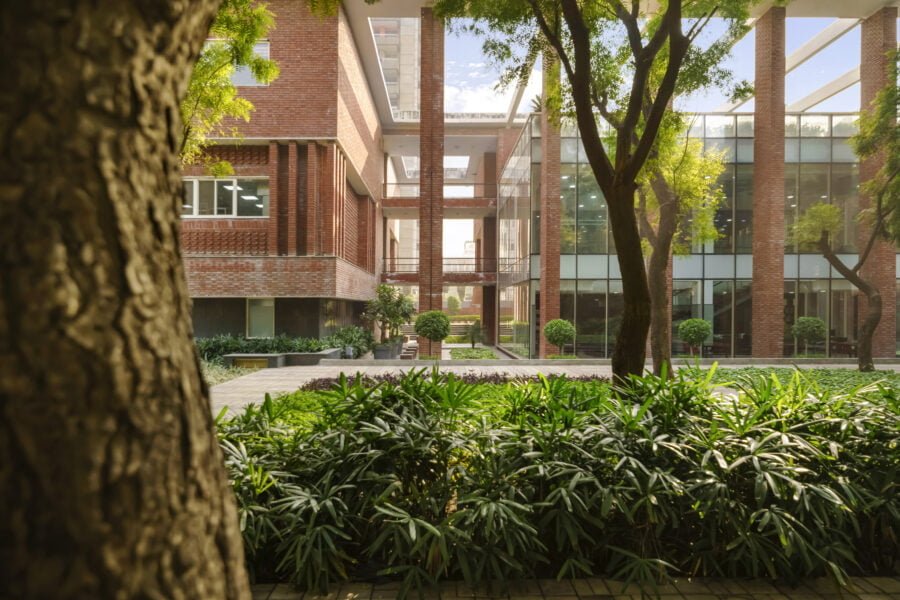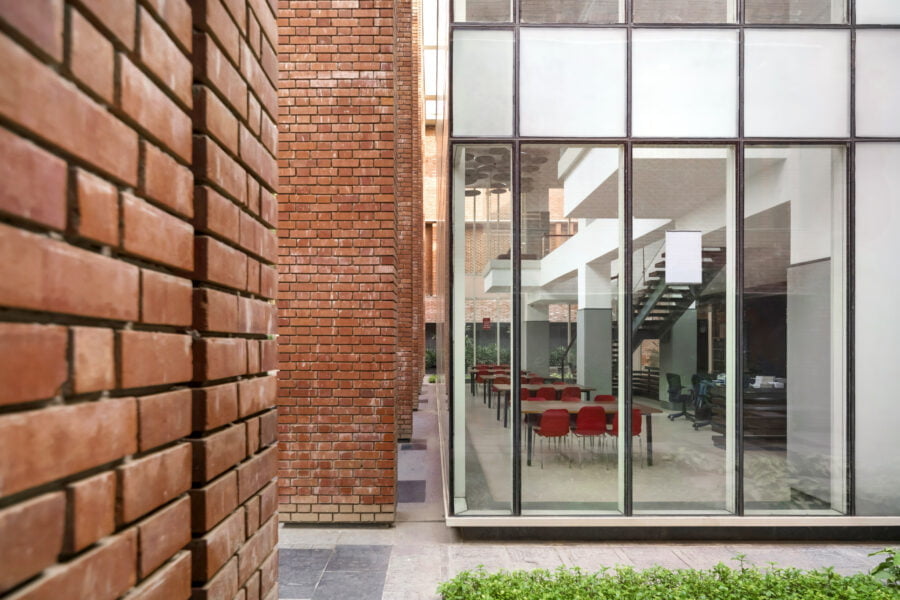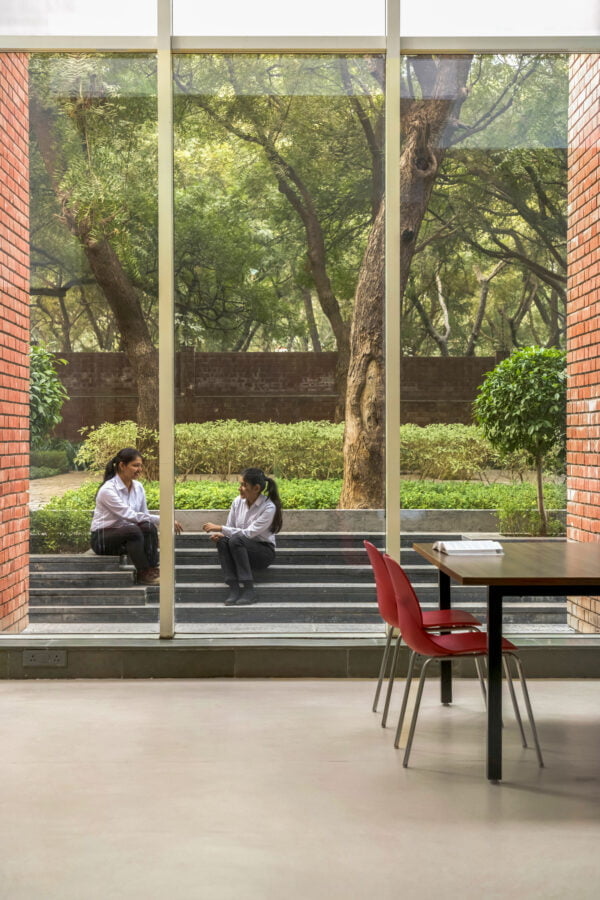| Project Name | The Lalit Suri Hospitality Institute |
| Typology: | Institutional |
| Location: | Faridabad, Haryana, India |
| Completion Year: | 2020 |
| Client: | Bharat Hotels Limited |
| Built-up Area: | 2,50,000 Sq.Ft |
| Site area | 5.00 Acres |
| Climate: | Composite |
| Credentials: | Consultants : Structure: RSM Consultants HVAC, Plumbing, Electrical, Fire Fighting: Apostle Studio Landscape Design: SJA Consultants Hospitality: Hotel Consultants India Green Consultant: Transven Acoustic: IN Basu and Associates Sustainability, Façade & Lighting Consultant: Morphogenesis Interior Designer: Morphogenesis* Contractors: Civil and Structural: M/s. Rajasthan Décor Interiors: Kernal Building Solution (only hostel block) Electrical: Apex Power HVAC: Apco AirconI Curtain Wall: Dhandhari Sah Team of Architects: Manit Rastogi, Sonali Rastogi, John Alok De Cruz |
Table of Contents
The Lalit Suri Hospitality School | Faridabad, Haryana
Informed by local building traditions, The Lalit Suri Hospitality School sustains a harmonious dialogue between the built and the landscape.
Located in Faridabad, in the suburbs of the National Capital Region (NCR) of New Delhi, The Lalit Suri Hospitality School imparts education in the service of luxury hospitality. The brief stipulated a design for a sustainable campus that would be set within a modest institutional framework and prepare students for a future in the Indian hospitality trade.
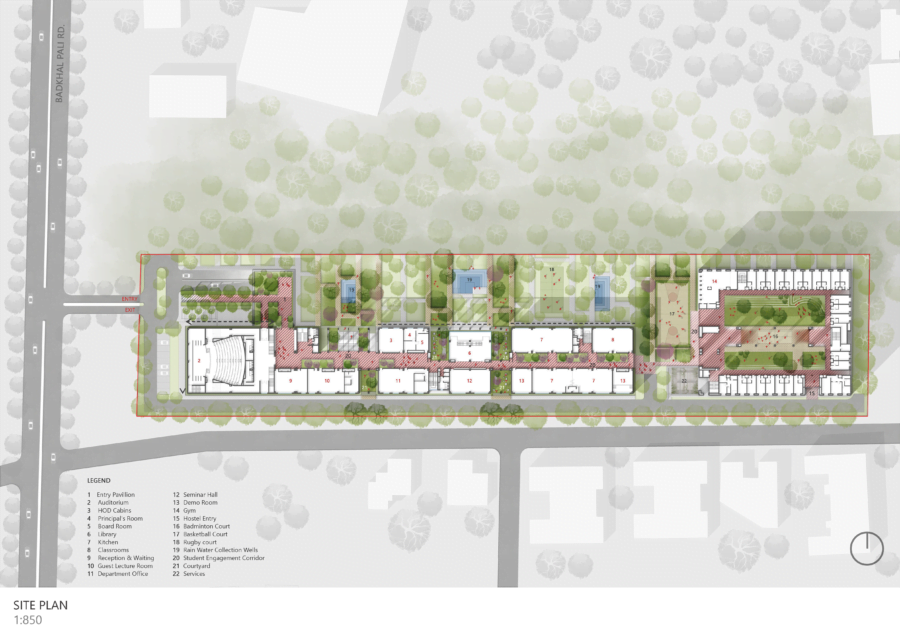
Programme and planning
The planning strategy focused on sensitively preserving and integrating an existing cluster of neem trees abutting the site’s northern edge. Therefore, the building actively engages and intertwines with the tree clusters by moving back and forth as required, resulting in multiple landscaped courtyards and shaded areas. The building height is kept low to give it a pedestrian-friendly human scale and allows for the seamless integration of the ‘green’ and the ‘built’.
The design approach addresses the institute’s vision of hospitality skills development, operational exposure, managerial competence, and a strategic outlook by ensuring that each space has a duality of purpose—one in its educational avatar, and one as a setting conducive to the experience of luxury hospitality. This flexibility in space-function is reflected across the entire project. Stepwells that are integrated within the design scheme are used as open-air theatres when empty.
Cafeterias double up as F&B outlets, where the students eat and learn service. The kitchens are designed to enable students to cook as well as practice their service skills. The entire hostel accommodation is built in a hotel format, where even public gathering spaces are designed to be serviced like congregational spaces within hotels.
All dormitories are multiples of a single optimized bay module. The hostel rooms are planned in a manner that allows the students to experience ‘hospitality’ in a hotel-room format. This modular approach to planning enhances the flexibility and diversity of spaces and operations. Open areas work as spill-over spaces to encourage interaction among the occupants.
Material palette

The primary material of choice was brick, which is synonymous with institutional buildings in India, and also being locally produced. Undulations and perforations in the facade enable ventilation and shading in the corridors, while the overhangs prevent the ingress of direct sunlight into the space, working concurrently to reduce heat gain. The design plays with different forms and levels of fenestrations, revealing interesting gaps, thus reinventing the tradition of the jaali and jharokha (a type of overhanging enclosed balcony).
The simple exposed brick facade with low wall-window ratios is used as a physical barrier that filters in 30% of outdoor light. The singular material for the entire project has various significant functions–being economical and low on maintenance while also lending a sense of timelessness and aiding psychological comfort.
Sustainability interventions
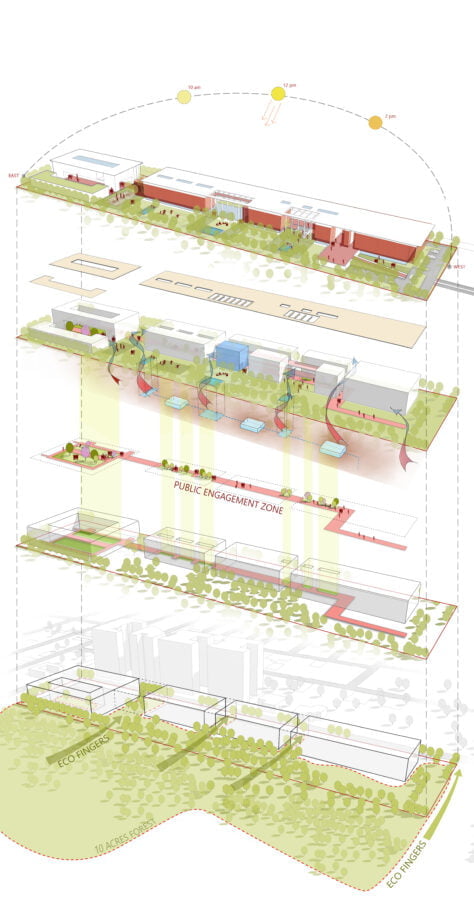
One of the critical aspects of the project was the zero tree-cutting goal, which has been successfully achieved through an optimized plan of permissible built volume with a 100% naturally ventilated central spine. The presence of lush foliage helps bring down summer temperatures through transpiration cooling. Moreover, the design of the school incorporates a series of passive cooling measures that reduce ambient temperatures within the building by up to 15 degrees.
The north-south orientation for minimal solar exposure acts as an effective self-shading component allowing the auditorium to buffer from solar gains. Summer winds traveling along the northwest-southeast direction are harnessed and redirected over the step-wells to improve thermal comfort during highly humid months. Landscaped courtyards enhance the cross-movement of fresh air within the building and reduce temperatures through the stack effect. Brick cavity walls, terrace gardens, and cantilever projections further reduce heat gain. The building is partially sunken, offering thermal banking and serving as an acoustic buffer from the adjacent main road.
The courtyard planning, incorporation of lightwells and thermal buffering, and the integration of greenery collectively reduce mechanical energy dependencies and optimize resource consumption, resulting in 100% of the academic area being Net Zero on energy (5,750 sq.m. roof area is provided for solar farming) with an EPI of ≤58kWh/sq.m./yr compared to the ECBC benchmark of 90 kWh/sq.m./yr.
Landscape interventions in The Lalit Suri Hospitality School

The landscape and the building levels respect the natural slope of the site. The building is also Net Zero on water during the monsoon since the need for large amounts of freshwater–about 3500 cubic meters, is addressed by collection wells and bioswales that harvest the rainwater, with up to 4900 cubic meters of water collected during the monsoon period.
The percolation of nature into the built form, dual functioning spaces, a muted material palette, and the combination of passive and active design strategies help create an educational campus that expresses the practice’s key pillars of sustainability, optimisation, uniqueness and liveability.
Morphogenesis
Morphogenesis is India’s leading Architecture and Urban Design practice with offices in Mumbai, Pune, Bangalore, and New Delhi. The firm was set up by Sonali and Manit Rastogi in 1996 with a vision of defining sustainable architecture for contemporary India.
Morphogenesis has been consistently ranked among the Top 100 Architectural Design Firms worldwide by Building Design Magazine, UK in WA100. The practice is the recipient of over 120 awards and has been featured in over 850 publications, both International and National. Sonali and Manit Rastogi have also been awarded Laureates of the Singapore Institute of Architects Getz Award for Emergent Architecture in Asia, Singapore, which seeks to bring recognition to Asian architects, who through their vision and commitment have made a significant contribution to shaping the changing landscape of Asia. The firm’s work has also been published in a Monograph by Images Publishing, Australia under their world-renowned Master Architect Series—a first for an Indian firm.
Our design approach has often been inspired by the vast repository of historical wealth of building knowledge and the strong arts and crafts traditions of the region. We understand that we are often working in an environment with limited resources and therefore, we deploy passive strategies by responding to the local climate and ecology while addressing comfort, safety, and liveability parameters. This has conservatively resulted in:
Over 9 million sq.m. of built environment benefitting over 5,60,000 inhabitants
Freshwater saved: 22 billion litres
Energy saved: 4.1 million kW/hr
Reduction in CO2 emissions: 4.2 billion kg
Gross area of sustainable buildings completed: 50,000,000 sq.ft.
Further, we believe each project must establish itself as a benchmark for innovative design by thinking systemically about sustainability. Architecturally, we celebrate identity and diversity versus visual homogeneity. Our belief in environmental design has resulted in the formulation of Morphogenesis’ copyrighted design process S.O.U.L.©2019, an acronym for:
Sustainable: Net zero energy, water, and waste to landfill
Optimized: Carbon neutral and use of local resources
Unique: Tradition, heritage, and culture
Liveable: Resilient communities
These parameters define the inquiry process that shapes our architecture. We measure the success of our projects by using design metrics before, during, and after a project’s completion. We believe it is this inclusive nature of design, focusing on passive and low-energy architecture, that will define emergent architecture in India.
